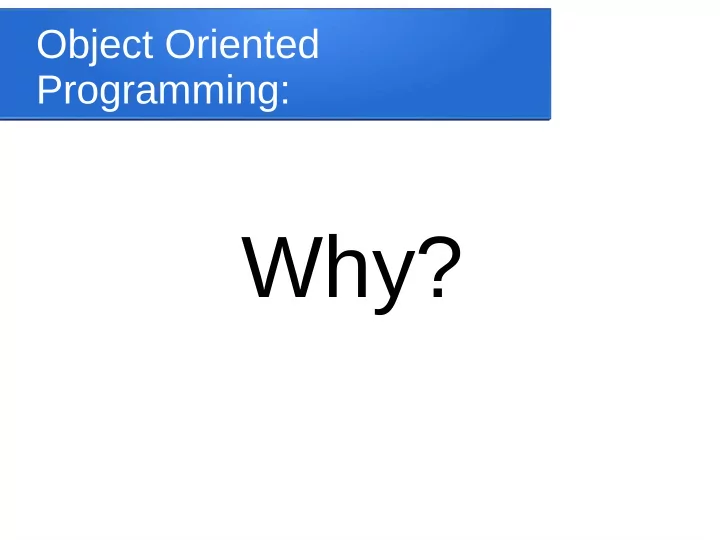

Object Oriented Programming: Why?
Today’s Goals: ● Introduce OOP philosophy ● Explain why OOP is useful ● Show OOP in action ● Explain OOP terminology
Review ● Classes are blueprints for data and methods that act on that data. – Think architectural designs for a house. ● Objects are instantiations of classes – Think the house they build from the designs ● Methods and Data are wrapped inside the class and their instantiations
What is an Class, Really? Two layers: ● Interface – Visible – Gives us external behaviors to rely on. ● Pre-/Post-conditions ● Implementation – Hidden – Produces the behavior specified by the interface
Whats the Difference? ● An interface is a list of methods, their behaviors and conditions – Describes ● An implementation is code, or pseudo- code, that performs specified behavior – Does
Whats the Difference? Interface for String: ● int length() – Returns number of characters in the string ● char charAt( int index ) – Pre-condition: index < length() – Returns the char at index ● int indexOf( char ch ) – Returns the index of the character ch in the string, -1 if not found ● Etc.
What’s the Difference? Possible Implementation for String: char[ ] charString; public int length(){ return charString.length; } public char charAt( int index ){ if( index >= this.length() ) throw new Exception(index + “ is out of bounds”); return this.charString[ index ]; } public int indexOf( char ch ){ for( int i = 0; i < this.length(); ++i){ if( this.charAt( i ) == ch ) return i; } return -1; } // etc.
Abstraction & Encapsulation These layers create: ● Abstraction – Creating a higher level view of an idea – The interface ● Encapsulation – Binding data and implementation within one thing – The implementation
Enough with the Vocabulary Cool, Abstraction, Encapsulation, so what? ● Abstraction allows us to use other classes without worrying how they work. – The interface tells us what they do. ● Encapsulation allows us to write classes that perform tasks: a) without having to divulge how it works b) making the task appear simpler to the outside
Which does...? ● Ultimately, when using an object we only care about what the object does, rather than how the object does it. ● This makes code: – Reusable – Easy to modify – Simple to use, despite its internal complexity
Abstraction and Interfaces Even with abstraction, there may be implementation details to consider: ● Speed ● Memory consumption But an interface allows for multiple implementations. Additionally, an interface is now a type, can we can instantiate objects of that type
Interface Syntax in Java Describes the methods that a class will implement: public interface IntegerList { // our interface public int remove(); // Defines that there is this method signature public int size(); public void add( int element ); // ...etc } public class IntegerArrayList implements IntegerList { public int remove(){ // implements this method // remove() method implementation code } // …etc }
Summary ● Classes and Objects are powerful constructs that allow for simplification of data-structures, increasing their usability and rebuildability by abstraction and encapsulation. ● Interfaces allow us to be unconcerned with implementation details when using a class; and alternatively, not be concerned with the use of the class when performing the implementation.
Recommend
More recommend